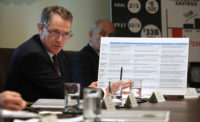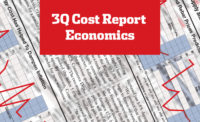Q4 Cost Report: Steel, Oil Prices to Drop in 2019 as Current Tariff Spike Subsides

While effects from tariffs triggered soaring material prices in 2018, a more modest escalation is expected in the upcoming year—in part due to an ongoing slowdown of construction starts. “In 2018, construction material costs are rising at levels last seen before the recession,” says Deni Koenhemsi, senior economist at IHS Markit. Material prices are up 7.5%, she says, largely driven by a 10% increase in fabrication steel and a 30% hike in refined petroleum products. In 2019, IHS Markit predicts a more modest 3.5% increase as price escalation for steel and fuel declines.
Steel sheet prices are “falling rapidly,” Koenhemsi points out. “Sheet is a buyer’s market through at least the first quarter of 2019, and likely persisting through midyear.” She says that “the major reason for declines is that prices were simply too high. The tariff rate is 25%, but in July 2018 hot-rolled sheet peaked at more than 50% above European prices.” She adds that “despite [tariffs], imports are strong and are pushing prices downwards. By early 2019 prices should reach a lower equilibrium.”
Oil prices are also beginning to fall. After a 30.3% increase in 2018, IHS Markit predicts a 2.2% decrease in the coming year. “Fears of a tightening supply environment have eased in recent months because of resilient production and an easing of sanctions on Iranian crude exports,” says Koenhemsi.
|
Related Link |
Alex Carrick, chief economist at ConstructConnect, has a similar outlook. “The preliminary round of U.S. tariffs on softwood lumber, steel and aluminum gave everyone a good scare,” he says. “It seemed construction material costs were rapidly heading skyward. But there have been several crosscurrents that have muted the effect through lowering the demand for inputs.”
Carrick cites three reasons for this turn of events: new car sales and housing starts that have slowed due to climbing interest rates; a delay in new projects due to the ongoing labor shortage; and the price of oil falling globally.
The economist warns, however, that this “period of relative calm” could come to an end should the U.S. impose another round of tariffs on Chinese goods. “Additional turmoil on the trade front may be the lever that tips the U.S. economy into a slowdown,” he adds.
In October, the Dodge Construction Outlook was released, predicting a flat escalation rate in construction starts in 2019. In the first 10 months of this year, starts were up 1%; construction spending was up 5% during the same time period, largely drawing on the strength in construction starts from 2016 and 2017, according to Robert A. Murray, chief economist and vice president of Dodge Data and Analytics.
“The strong tailwinds provided by healthy economic growth, as well as greater funding resulting from the March 23 omnibus federal appropriations legislation and recent state and local bond measures, have been able to offset this year’s headwinds,” says Murray. “For 2019, however, that offset may not be present to the same extent, as the benefits of tax reform on overall economic growth will wane.”
Overall, ENR’s Building Cost Index is expected to rise 3% in 2019, following a 3.2% increase this year. ENR’s Construction Cost Index, which has jumped 2.9% this year, is also predicted to increase 3% in the coming 12 months. Union labor rates make up 81% of the CCI and 66% of the BCI.
The Construction Labor Research Council, which tracks union wage-fringe settlements, reports that through September, wages have increased an average of 3% throughout the U.S. Regionally for all crafts, the Northwest experienced the highest increase at 4.5%, while the Southeast region saw the lowest rise, at 2.1%. Among crafts, insulators have seen the highest wage hike through the first nine months of 2018, at 4.5%




